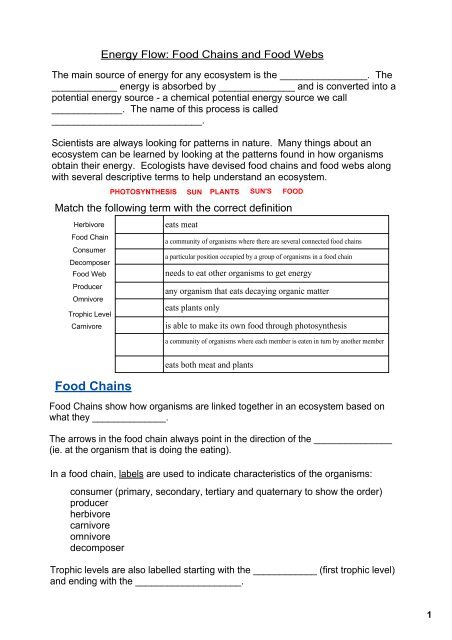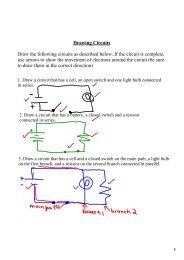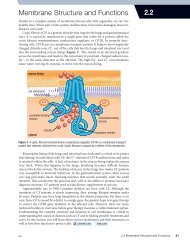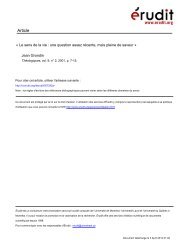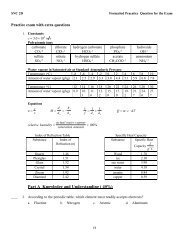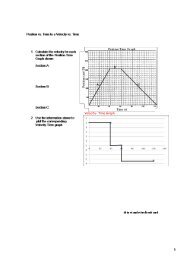You also want an ePaper? Increase the reach of your titles
YUMPU automatically turns print PDFs into web optimized ePapers that Google loves.
Energy Flow: <strong>Food</strong> <strong>Chains</strong> and <strong>Food</strong> WebsThe main source of energy for any ecosystem is the ________________. The____________ energy is absorbed by ______________ and is converted into apotential energy source a chemical potential energy source we call_____________. The name of this process is called____________________________.Scientists are always looking for patterns in nature. Many things about anecosystem can be learned by looking at the patterns found in how organismsobtain their energy. Ecologists have devised food chains and food webs alongwith several descriptive terms to help understand an ecosystem.PHOTOSYNTHESISSUNPLANTSSUN'SMatch the following term with the correct definitionHerbivore<strong>Food</strong> ChainConsumerDecomposer<strong>Food</strong> WebProducerOmnivoreTrophic LevelCarnivoreeats meatFOODa community of organisms where there are several connected food chainsa particular position occupied by a group of organisms in a food chainneeds to eat other organisms to get energyany organism that eats decaying organic mattereats plants onlyis able to make its own food through photosynthesisa community of organisms where each member is eaten in turn by another member<strong>Food</strong> <strong>Chains</strong>eats both meat and plants<strong>Food</strong> <strong>Chains</strong> show how organisms are linked together in an ecosystem based onwhat they ______________.The arrows in the food chain always point in the direction of the _______________(ie. at the organism that is doing the eating).In a food chain, labels are used to indicate characteristics of the organisms:consumer (primary, secondary, tertiary and quaternary to show the order)producerherbivorecarnivoreomnivoredecomposerTrophic levels are also labelled starting with the ____________ (first trophic level)and ending with the ____________________.1
Label the following food chainRole and OrderTypes of organismsTrophic Levelplantsgrasshoppers small birds hawksuse the words in the banksto label the food chain above<strong>Food</strong> WebsRole and order word bankconsumer secondaryproducerprimarytertiary decomposerTypes of organisms word bankomnivore carnivoreherbivorecarnivoreherbivoreIn an ecosystem, many different ____________________ exist together creating a__________________________.A __________________ shows the energy flow within an ecosystem starting withthe ____________________ and ending with the __________________.Label the following food webName 3 primaryconsumers.What organisms are thetop carnivores?Draw one food chain that is within this food web.What would happen if the herbivorous insects became extinct? Explain how thismight effect other organisms in the food web..2
<strong>Food</strong> <strong>Chains</strong> and <strong>Food</strong> Webs Homework<strong>Food</strong> <strong>Chains</strong><strong>Food</strong> chains show how organisms are connected through what they eat. The arrows in the chain always pointin the direction the energy flows (towards the organism doing the eating).1. Using the organisms listed draw a food chain on the top of the next page. Your food chain shouldstart with the producer and end with the organism that is not eaten by any other. Make sure yourarrows are pointing in the direction of the energy flow. (leave space around your food chain to addlabels)GrasshopperOwlMoleGrass2. Label the following on your food chain:producer(s)consumer(s)herbivore(s)carnivore(s)1st trophic level2nd trophic level3rd trophic level4th trophic levelThe first consumer in the food chain is known as the primary consumer. The second consumer is known asthe secondary consumer. The third consumer is known as the tertiary consumer.3. Add the labels primary consumer, secondary consumer and tertiary consumer to your food chain asnecessary.4. Remember that we, as humans, are consumers. Below each of the following meals, draw the food chainfrom producer to you. Label each food chain fully.a. A salmon fillet (The salmon eats herbivorous fish)b. A steakc. A bowl of plain rice (think about what rice comes from!).3
<strong>Food</strong> Webs1. How many organisms form the longest foodchain in the food web?tree2. Which organism in this food chain isowlhawka) the top carnivore(s) (hint nothing eats thetop carnivore)b) a herbivorespidercaterpillarfoxc) a producerd) at the 2nd trophic leveldeerrobinmosquitomousee) is a tertiary consumerchipmunkgrasshopper3. Write this food chain out (make sure your arrows point in the right direction!)*Label your food chain fully use your notes as an examplerabbitgrass4. Is there an omnivore in this food web? Explain your answer.5. List all the primary consumers in this food web.6. If all the squirrels were killed by a virus, what would happen to this food web? Would itremain sustainable? Explain your answer in detail.7. If a pack of coyotes entered this ecosystem, how would it be impacted? Explain youranswer in detail..4
HomeworkRead the following description of the relationship between bees, clover flowers, dormice and humans.Answer the following questions using complete sentences.Bees collect a sugar rich liquid, nectar, from clover flowers. They convert the nectar into honey which theyuse to feed their larvae and also as a winter food store. Humans and dormice are both fond of honey anddormice will also eat bee larvae in the honeycomb. Other animals such as cats and hawks will feed ondormice.1) From this information draw a food chain involving four organisms starting from the clover flower.2) In what form does energy enter this food chain?3) Into which form is this energy converted by the clover plant?4) Why do clover flowers produce nectar?5) Give two reasons why the bees need to store honey for the winter.6) If a beekeeper removes honey from the hive in autumn she will provide the bees with sugar solution.Suggest a reason for this.5


